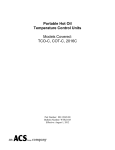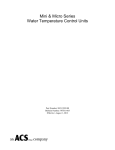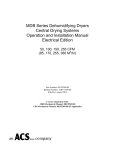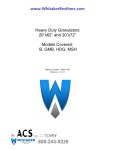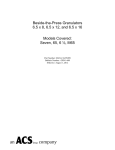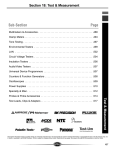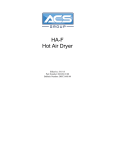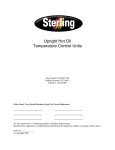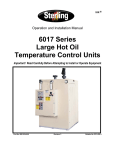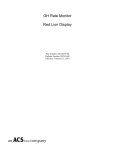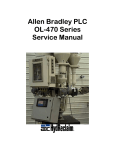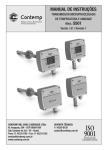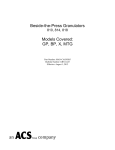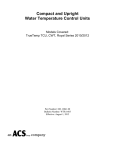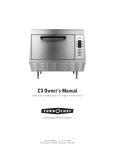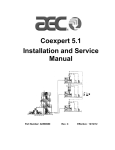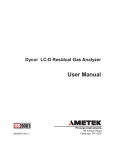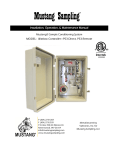Download 882.12042.00 Midsize Hot Oil Units WTR2-635
Transcript
Midsize Hot Oil
Temperature Control Units
Models Covered:
TCO, 2016M, COT
Part Number: 882.12042.00
Bulletin Number: WTR2-635
Effective: August 1, 2012
Write Down Your Serial Numbers Here For Future Reference:
_________________________
_________________________
_________________________
_________________________
_________________________
_________________________
We are committed to a continuing program of product improvement.
Specifications, appearance, and dimensions described in this manual are subject to change without notice.
DCN No. ____________
© Copyright 2013
All rights reserved.
WTR1-935
ii
Shipping Info
Unpacking and Inspection
You should inspect your hot oil temperature control unit for possible shipping damage.
Thoroughly check the equipment for any damage that might have occurred in transit, such as
broken or loose wiring and components, loose hardware and mounting screws, etc.
In the Event of Shipping Damage
According to the contract terms and conditions of the Carrier, the responsibility of the
Shipper ends at the time and place of shipment.
Notify the transportation company’s local agent if you discover damage.
Hold the damaged goods and packing material for the examining agent’s inspection. Do not
return any goods before the transportation company’s inspection and authorization.
File a claim with the transportation company. Substantiate the claim by referring to the
agent’s report. A certified copy of our invoice is available upon request. The original Bill of
Lading is attached to our original invoice. If the shipment was prepaid, write us for a
receipted transportation bill.
Advise customer service regarding your wish for assistance and to obtain an RMA (return
material authorization) number.
If the Shipment is Not Complete
Check the packing list as back-ordered items are noted on the packing list. You should have:
þ Bill of lading
þ Packing list
þ Operating and Installation packet
þ Electrical schematic and panel layout drawings
þ Component instruction manuals
Re-inspect the container and packing material to see if you missed any smaller items during
unpacking.
If the Shipment is Not Correct
If the shipment is not what you ordered, contact the shipping department immediately. For
immediate assistance, please contact the correct facility located in the technical assistance
section of this manual. Have the order number and item number available. Hold the items
until you receive shipping instructions.
WTR1-935
iii
Returns
Do not return any damaged or incorrect items until you receive shipping instructions from the
shipping department.
Credit Returns
Prior to the return of any material authorization must be given by the manufacturer. A
RMA number will be assigned for the equipment to be returned.
Reason for requesting the return must be given.
ALL returned material purchased from the manufacturer returned is subject to 15% ($75.00
minimum) restocking charge.
ALL returns are to be shipped prepaid.
The invoice number and date or purchase order number and date must be supplied.
No credit will be issued for material that is not within the manufacturer’s warranty period
and/or in new and unused condition, suitable for resale.
Warranty Returns
Prior to the return of any material, authorization must be given by the manufacturer. A
RMA number will be assigned for the equipment to be returned.
Reason for requesting the return must be given.
All returns are to be shipped prepaid.
The invoice number and date or purchase order number and date must be supplied.
After inspecting the material, a replacement or credit will be given, at the manufacturer’s
discretion. If the item is found to be defective in materials or workmanship, and it was
manufactured by our company, purchased components are covered under their specific
warranty terms.
WTR1-935
iv
Table of Contents
CHAPTER 1: SAFETY................................................................ 7 1-1 How to Use This Manual .............................................................................................. 7 Safety Symbols Used in this Manual ..................................................................... 7 1-2 Warnings and precautions ............................................................................................ 9 CHAPTER 2: FUNCTIONAL DESCRIPTION ........................... 10 2-1 2-2 2-3 2-4 2-5 Models Covered in This Manual ................................................................................. 10 General Description .................................................................................................... 10 Typical Features and Components ............................................................................. 10 Feature Descriptions .................................................................................................. 12 Safety Features .......................................................................................................... 16 CHAPTER 3: INSTALLATION ................................................. 18 3-1 Work Rules ................................................................................................................. 18 3-2 Installation Requirements ........................................................................................... 18 3-3 Connecting Piping ...................................................................................................... 19 CHAPTER 4: OPERATION ...................................................... 23 4-1 Start-up ....................................................................................................................... 23 4-2 Shut-down .................................................................................................................. 24 Unit Shut Down (With Autovent Solenoid or Manual Vent Valve) ............................. 24 4-3 Returning Fluid to the Tank ........................................................................................ 25 CHAPTER 5: USING CONTROLS AND INDICATORS ........... 26 5-1 5-2 5-3 5-4 The Microprocessor Controller ................................................................................... 26 Controller Display ....................................................................................................... 26 Identifying Control Panel Switches ............................................................................. 27 Identifying System Status Board Indicators ................................................................ 28 CHAPTER 6: MAINTENANCE ................................................. 31 6-1 Periodic Checks .......................................................................................................... 31 Making Daily Checks ........................................................................................... 31 Making Monthly Checks ...................................................................................... 31 Making Quarterly Checks .................................................................................... 31 Making Six-Month Checks ................................................................................... 31 6-2 Routine Servicing ....................................................................................................... 32 6-3 Draining the Unit for Storage ...................................................................................... 32 6-4 Corrective Maintenance .............................................................................................. 32 6-5 Maintaining the Pump ................................................................................................. 33 CHAPTER 7: TROUBLESHOOTING ....................................... 46 7-1 Introduction ................................................................................................................. 46 CHAPTER 8: APPENDIX ......................................................... 49 WTR1-935
v
8-1 Technical Assistance .................................................................................................. 49 Parts Department ................................................................................................ 49 Sales and Contracting Department ..................................................................... 49 Facilities .............................................................................................................. 49 WTR1-935
vi
Chapter 1: Safety
1-1
How to Use This Manual
Use this manual as a guide and reference for installing, operating, and maintaining your
granulator. The purpose is to assist you in applying efficient, proven techniques that enhance
equipment productivity.
This manual covers only light corrective maintenance. No other maintenance should be
undertaken without first contacting a service engineer.
The Functional Description section outlines models covered, standard features, and safety
features. Additional sections within the manual provide instructions for installation, preoperational procedures, operation, preventive maintenance, and corrective maintenance.
The Installation chapter includes required data for receiving, unpacking, inspecting, and setup
of the equipment. We can also provide the assistance of a factory-trained technician to help
train your operator(s) for a nominal charge. This section includes instructions, checks, and
adjustments that should be followed before commencing with operation of the granulator.
These instructions are intended to supplement standard shop procedures performed at shift,
daily, and weekly intervals.
The Operation chapter includes a description of electrical and mechanical controls, in
addition to information for operating the granulator safely and efficiently.
The Maintenance chapter is intended to serve as a source of detailed assembly and
disassembly instructions for those areas of the equipment requiring service. Preventive
maintenance sections are included to ensure that your granulator provides excellent, long
service.
The Troubleshooting chapter serves as a guide for identification of most common problems.
Potential problems are listed, along with possible causes and related solutions.
The Appendix contains technical specifications, drawings, schematics, parts lists, and
available options. A spare parts list with part numbers specific to your machine is provided
with your shipping paperwork package. Refer to this section for a listing of spare parts for
purchase. Have your serial number and model number ready when ordering.
Safety Symbols Used in this Manual
The following safety alert symbols are used to alert you to potential personal injury hazards.
Obey all safety messages that follow these symbols to avoid possible injury or death.
DANGER indicates an imminently hazardous situation that, if not
avoided, will result in death or serious injury.
WARNING indicates a potentially hazardous situation or practice that, if
not avoided, could result in death or serious injury.
CAUTION indicates a potentially hazardous situation or practice that, if
not avoided, may result in minor or moderate injury or in property damage.
WTR2-635
Chapter 1: Safety
7 of 50
Hazard Alert
Symbol
Mandatory
Symbol
Description/Explanation
Preventative Maintenance
High Voltage Hazard. The electrical
enclosure is supplied with 3-phase electrical
power. Use caution when using or
maintaining this product.
Hot Surface Hazard. When the unit operates
above 212F (100C) the surface of the unit
may reach excessive temperatures. Use
caution when using or maintaining this
product.
Pinch Point/Entanglement. The pump and
motor are linked using v-groove belts. Use
caution when using or maintaining this
product.
Every six months inspect all electrical
connections for secure attachment. For
further information see the
Maintenance Chapter in this manual
Every six months inspect all surfaces
for signs of heat degradation. If any
appear remove panel and verify cause
of degradation and repair.
Every month inspect the belt(s) for any
type of wear. For further information
see the Maintenance Chapter in this
manual.
Description/Explanation
Read Operators Manual. This equipment must be operated and maintained by properly
trained personnel. The information contained within this manual must be read and
understood prior to operating this equipment.
Lock Out. This equipment is operated with 3-phase electrical power. Therefore, when
performing any maintenance operations we recommend following the local standards
for performing a lock-out/tag-out procedure.
Wear Safety Gloves. This equipment operates above 212F (100C) and its surfaces may
reach excessive temperatures. We recommend that technicians use safety gloves while
performing maintenance to protect hands from being exposed to these hot surfaces.
WTR2-635
Chapter 1: Safety
8 of 50
1-2
Warnings and precautions
Our units are designed to provide safe and reliable operation when installed and operated
within design specifications, following national and local safety codes.
To avoid possible personal injury or equipment damage when installing, operating, or
maintaining this granulator, use good judgment and follow these safe practices:
þ Follow all SAFETY CODES.
þ Wear SAFETY GLASSES and WORK GLOVES.
þ Disconnect and/or lock out power before servicing or maintaining the hot oil
temperature control unit.
þ Use care when LOADING, UNLOADING, RIGGING, or
þ MOVING this equipment.
þ Operate this equipment within design specifications.
þ OPEN, TAG, and LOCK ALL DISCONNECTS before working on equipment.
You should remove the fuses and carry them with you.
þ Make sure the hot oil temperature control unit and components are properly
GROUNDED before you switch on power.
þ Do not jump or bypass any electrical safety control.
þ Do not restore power until you remove all tools, test equipment, etc., and the hot oil
temperature control unit and related equipment are fully reassembled.
þ Only PROPERLY TRAINED personnel familiar with the information in this
manual should work on this equipment.
We have long recognized the importance of safety and have designed and manufactured our
equipment with operator safety as a prime consideration. We expect you, as a user, to abide
by the foregoing recommendations in order to make operator safety a reality.
WTR2-635
Chapter 1: Safety
9 of 50
Chapter 2: Functional Description
2-1
Models Covered in This Manual
This manual lists installation, operation, and maintenance instructions for the hot oil portable
temperature control unit.
Model numbers are listed on the serial tag. A model number followed by -Q indicates a
specially constructed unit, and not all information in this manual may apply. Make sure that you
know the model number, serial number, and operating voltage of your unit if you contact us.
2-2
General Description
Your hot oil temperature control unit circulates thermal transfer-type oil through your
process and to precisely, automatically, and reliably maintain it at a temperature you can select.
The operating range of your temperature control unit is from 100°F to 550°F (38°C to 288°C).
The unit is best suited for use with TrueTherm™ Heat Transfer Fluid. A recommended list of
commercially available heat transfer fluids can be obtained through customer service.
Rapid recirculation of the relatively small amount of fluid provides a close and uniform
temperature relationship between the TO PROCESS and FROM PROCESS lines. This does, of
course, depend on the configuration of your process, and any restrictions within the mold.
This recirculation, combined with the immersion heater and optional cooling capability, gives
fast and accurate response to bring the fluid up to temperature, or to changes in the settings
when needed.
Performance is assured through matching the unique controllers to the high temperature system.
The two systems are fully integrated to achieve accurate control, along with efficient use of
water and electricity.
2-3
Typical Features and Components
Standard Features
WTR2-635
•
Off-the-shelf microprocessor-based PID temperature controller
with Process and Set Point LED readouts
•
Non-fused lockable rotary disconnect
•
Dual stage immersion heater with IEC contactors
•
550°F (288ºC) maximum operating temperature {400ºF (244ºC)
maximum operating temperature for 6 kW heater}
•
Manual bypass
•
Branch fusing
•
System status graphic display
•
Pressure switch for low pump pressure shut-down
•
NEMA 12 electrical enclosure
•
UL listed subpanel
Chapter 2: Functional Description
10 of 50
•
To Process pressure gauge
•
Independent safety thermostat
•
Y strainer on From Process line
•
Automatic venting sequence
•
Positive displacement pumps capable of reversing to evacuate
the process
•
Low level alarm for reservoir
•
Easily removable panels for quick access to internal
components
Audible alarm
•
Available Options
WTR2-635
•
Drain valve
•
Hour meter; measures total pump run time hours
•
General fault visual alarm
•
Autovent sequence; deducts available
•
Low level alarm; deducts available
•
High level indicator light
•
Manual bypass; deducts available
•
Heat exchanger options of 3.9 sq. ft. (0.3627 sq. m) and 6.7 sq. ft.
(0.6231 sq. m)
•
Remote controller
•
Lexan cover
•
Optional operating voltages of 208/3/60, 230/3/60, 575/3/60,
380/3/50, and 415/3/50
Chapter 2: Functional Description
11 of 50
2-4
Feature Descriptions
Immersion Heaters
The fluid is heated by the specially designed three-phase low watt density electrical immersion
heater, and regulated by the controller. The standard heater has a steel sheath for low watt
density and good heat transfer.
These models can be supplied with 6, 12, 18, 24 kW low watt density immersion heaters,
depending upon the heating needs of the process. The 18 and 24 kW models are built to provide
full or partial heat as required by the process and determined by the controller, to provide more
precise control.
Heater Tank
The M features a single pass heater tank. The tank is designed to maintain an optimum balance
of fluid velocity versus watt density, and turbulence for excellent heat transfer, and minimal
pressure drop. The high fluid velocity will greatly prolong the life of the heater and fluid.
Pump
The pump is a mechanical seal, positive displacement pump. It features a nearly maintenance
free design, and was selected after extensive testing to provide superior performance, flexibility
and low maintenance. It is well suited for use with a variety of commercially available heat
transfer fluids. The pump has only two internal moving parts, and a specially designed seal to
give years of trouble free service, even at high temperatures. The only routine maintenance
required is the monthly greasing and occasional head space adjustment; see Section 6-2 on Page
42 for more information.
The pump is capable of running in either direction. Thus, the pump reverse feature can be used
to draw fluids back from the process. It is not necessary to install a service air line to purge the
lines before changing molds. Since the pump is capable of achieving extremely high pressures,
it is necessary to regulate the pressure through use of a regulating by-pass line (Ful-Flo valve).
Because the pump is a positive displacement pump, it will supply the process with rated flow at
or below the rated pressure.
The flow is constant until the pressure reaches the rated pressure. The pressure however is a
function of frictional losses through the process that it is attached to. Systems with large process
connections, ports, and piping will operate at low pressures. While systems with small process
connections, ports, and piping will operate at higher pressures. Once the pressure requirements
exceed the rated pressure, the fulflow valve will open and bypass the necessary fluid to prevent
high pressures.
Ful-Flo Valve
A regulating by-pass line featuring a Ful-Flo valve is standard in all units. This is a safety
device to prevent excessive pressure in the event that the delivery line is obstructed. Each FulFlo is factory preset to limit system pressure as specified by the customer. It must not be
tampered with in any way.
In the event of an obstruction in the line, the Ful-Flo will open and divert fluid from the delivery
TO PROCESS line to the return From Process line. A constant flow of fluid is maintained
through the heater tank to prevent damage to the heating elements and fluid.
WTR2-635
Chapter 2: Functional Description
12 of 50
Cooling (Optional)
The specially-made shell and tube heat exchanger is provided as optional equipment in this unit.
The design features U- tube construction and copper-nickel tubes for durability and optimal heat
transfer.
The modular construction allows the tube bundle to be easily removed for periodic cleaning.
Additionally, check valves are installed on the water supply and drain lines to prevent water
from back flowing into the heat exchanger from a closed drain or into the water supply piping.
The controller automatically regulates cooling by opening and closing the cooling solenoid.
This allows the proper amount of cooling water to pass through the tubes of the heat exchanger
and out the drain. A water supply of 75 psi (517.1 kPa/5.2 bars) maximum is required for
connection to the heat exchanger.
Connection Lines
Connections for TO PROCESS and FROM PROCESS lines are 1" NPT (25.4 mm). Water
connections for COOLING WATER SUPPLY and COOLING WATER DRAIN are 0.75” NPT
(19.1 mm). (see Section 3.) The customer is responsible for conversions to metric standards.
We stock many lengths of flexible metal hose; the part number is 572-16969. State the length of
hose you want when ordering.
Component failure may result in high-temperature oil spray, causing serious injury or death.
Make sure hoses, valves, and other components installed in your process can withstand
maximum temperature and pressure of the M unit; check unit nameplate for specific
capacities. All components must be carefully inspected for condition before installing. Make
sure you have factory components if you have any doubt.
Electrical System Controls
simplicity of operation. The switches are clearly labeled as to their function. Your M unit has a
system status board so you can evaluate the status and performance of the unit at a glance. Pilot
lights are provided to indicate key unit functions.
An audible alarm is standard with your unit. The alarm will sound in the event of the following
conditions:
• motor overload
• safety thermostat trip (over temperature)
• low fluid pressure
• low fluid level
• high fluid level (optional)
Push the ALARM SILENCE button to silence the alarm. See Section 5-1 on page 26 for more
information on control functions.
Electrical Panel and System Components
The pump motor and immersion heater operate on three-phase, 50/60 cycle, nominal voltage
with the control circuit at 115 V single phase. The control circuit voltage is provided by a single
phase machine tool transformer with primary fuse protection and a grounded secondary. A main
power disconnect is included as for ease of service. The electrical panel is UL listed and
complies with N.F.P.A. 79 provisions.
All components are IEC rated for long life and reduced maintenance. The heater elements are
branch fused, and protected from contactor welding by a separate primary voltage contactor.
WTR2-635
Chapter 2: Functional Description
13 of 50
The pump motor is controlled by a full voltage magnetic reversing starter, with fused branch
circuit overcurrent and thermal overload protection. Many additional features are available as
options.
A NEMA 12 enclosure is standard, with NEMA 4 available as an option.
Air Purge
Upon initial start-up and mold/process change-out, you’ll need to purge all air and water from
the system. The M unit has appropriate valving to ensure complete purging.
Failure to purge the system of air before heating may result in serious injury or critical
system and equipment damage.
Make sure you properly purge the system of air before starting the heater cycle
Pressure Switch
A pressure switch is built into each unit to guard against heater damage. This feature prevents
the heater elements from being energized unless the pump is running and fluid is in the system.
After a preset time, the pump shuts down if the fluid pressure is not re-established. The pressure
switch is preset at the factory; do not tamper with it.
Safety Thermostat
The safety thermostat is a J-Thermocouple sensing, adjustable, fail-safe device located in the
heater tank. This is to guard against the unlikely event of “runaway” heating. If overheating
does occur, the safety thermostat shuts down the heater outputs and sounds an audible alarm. A
red pilot light on the status board also illuminates.
The unit continues to pump fluid through the system to prevent heater damage. Auxiliary
factory installed alarms such as beacons and klaxons are available as options.
All controller functions are locked out until the main supply power is disconnected. Resetting
the alarm condition is initiated by depressing the red pump stop button. The reset button is
located inside the electrical enclosure, mounted on the left wall of the enclosure. It is imperative
that a qualified maintenance technician determine and correct the cause of the fault before
resuming operation.
Reservoir Tank
A reservoir tank with sight gauge is standard; usable capacity is seven (7) gallons (26.5 liters).
The tank permits thermal expansion of the heat transfer fluid, and provides make-up fluid.
The reservoir tank may cause serious injury if it ruptures from not being properly vented.
Make sure that the reservoir tank is always properly vented to prevent tank rupture.
The reservoir tank drain is extended beyond the base of the unit for ease of draining. Optional
ball valves are available to further simplify draining.
WTR2-635
Chapter 2: Functional Description
14 of 50
Figure 1
Midsize Hot Oil Portable Temperature Control Unit
WTR2-635
Chapter 2: Functional Description
15 of 50
2-5
Safety Features
This section includes information on safety devices and procedures that are inherent to the
portable hot oil tcu. This manual is not intended to supersede or alter safety standards
established by the user of this equipment. Instead, the material contained in this section is
recommended to supplement these procedures in order to provide a safer working environment.
At the completion of this section, the operator and maintenance personnel will be able to do the
following:
•
Identify and locate specific safety devices.
•
Understand the proper use of the safety devices provided.
•
Describe the function of the safety device.
Safety Circuit Standards
Safety circuits used in industrial systems protect the operator and maintenance personnel from
dangerous energy. They also provide a means of locking out or isolating the energy for
servicing equipment.
Various agencies have contributed to the establishment of safety standards that apply to the
design and manufacture of automated equipment. The Occupational Safety and Health
Administration (OSHA) and Joint Industrial council (JIC) are just a few of the organizations
that have joined with the plastics industry to develop safety standards.
Every effort has been made to incorporate these standards into the design of the portable hot oil
tcu; however, it is the responsibility of the personnel operating and maintaining the equipment
to familiarize themselves with the safety procedures and the proper use of any safety devices.
Fail Safe Operation
If a safety device or circuit should fail, the design must be such that the failure causes a “Safe”
condition. As an example, a safety switch must be a normally open switch. The switch must be
held closed with the device it is to protect. If the switch fails, it will go to the open condition,
tripping out the safety circuit.
At no time should the safety device fail and allow the operation to continue. For example, if a
safety switch is guarding a motor, and the safety switch fails, the motor should not be able to
run.
WTR2-635
Chapter 2: Functional Description
16 of 50
Safety Device Lock-Outs
Some safety devices disconnect electrical energy from a circuit. The safety devices that are
used on these temperature control units are primarily concerned with electrical power
disconnection and disabling of moving parts that may need to be accessed during the normal
operation of the machine.
Some of the safety devices utilize a manual activator. This is the method of initiating the safety
lock out. This may be in the form of a plug, lever, or a handle. Within this lockable handle,
there may be location for a padlock. Personnel servicing the equipment should place a padlock
in the lockout handle.
In addition to the safety devices listed above, these temperature control units are equipped with
a line cord plug. This allows the operator or maintenance personnel to unplug the tcu from its
power source and tag it out. The plug can then be tagged with any number of approved
electrical lockout tags available at most electrical supply stores.
Always disconnect and lockout all electrical power and pneumatic (i.e. compressed air)
sources prior to servicing or cleaning the temperature control unit. Failure to do so may
result in serious injury. No one but the person who installed the lockout may remove it.
WTR2-635
Chapter 2: Functional Description
17 of 50
Chapter 3: Installation
3-1
Work Rules
The installation, operation, and maintenance of this equipment must be conducted in accordance
with all applicable work and safety codes for the installation location. This may include, but is
not limited to OSHA, NEC, CSA, and any other local, national, and international regulations.
• Read and follow these instructions when installing, operating, and maintaining
this equipment. If the instructions become damaged or unreadable, obtain
additional copies from ACS Group.
•
Only qualified personnel familiar with this equipment should work on or with
this hot oil temperature control unit.
• Work with approved tools and devices.
• Disconnect the electricity before maintenance or service.
If the unit is installed with a power cord that can be un- plugged, unplug it. If the unit is
permanently wired to a power main, make sure that a fused power disconnect is installed to
allow the disconnect to be locked in the OFF position. Open and lock out the disconnect
installed in the control enclosure.
3-2
Installation Requirements
Make sure that you meet the following requirements when installing and operating your M hot
oil temperature control unit.
Installation Location Considerations
Locate the M unit as close as possible to the process for proper circulation and temperature
control. Take care when selecting a location. The area surrounding the unit must be free of
obstructions to ensure proper ventilation of internal components. Allow a minimum clearance
of at least 30 inches (76 cm).
Make sure that the unit location is not in a confined space to ensure proper air circulation.
Special air circulation/ventilation is required for units operating at temperatures exceeding
500ºF (260ºC). Vapors can escape from areas such as the reservoir tank during
high temperature operation.
Harmful vapors may be generated from thermal fluid during high temperature operation.
Prolonged or repeated exposure of these hot-generated vapors may result in eye and
respiratory tract irritation. Avoid contact or inhaling harmful amounts of material. Consult
the Material Safety Data Sheet (MSDS) for precautions and instructions for the thermal
fluid you are using.
Before storing your M temperature control unit, make sure you remove
all residual water with compressed air to avoid a potential freezing
hazard. See Section 6-3 for more information.
WTR2-635
Chapter 3: Installation
18 of 50
Note the following table of ambient temperature ranges permitted for storage
and operation:
Ambient storage range
ºF
ºC
-40ºF to 185ºF
-40ºC to 85ºC
Ambient operation range
ºF
ºC
-4ºF to 120ºF
-20ºC to 49ºC
You should preheat the process heat transfer fluid first if you want to start the
unit below an ambient temperature of 30ºF (-1ºC).
3-3
Connecting Piping
Make sure that all external piping is properly sized to reduce external pressure drop as much as
possible. Do not install process or water supply/drain piping smaller than the fittings on the unit.
If the water supply piping is larger than unit fittings, reduce the pipe size at the unit.
The following table lists M/TCU pipe sizes.
Size diameter
Connection
inches NPT mm (approx.) c
To Process
1” NPT
25.4 mm
From Process
1” NPT
25.4 mm
Cooling Water Supply
0.75” NPT
19.1 mm
Cooling Water Drain
0.75” NPT
19.1 mm
Oil Drain
0.5” NPT
12.7 mm
Fill Port
1” NPT
25.4 mm
c Customer is responsible for converting to metric.
Always use a backup wrench to support M unit piping when making
connections. Make sure all external piping is supported independently
of the M unit.
It is recommended that you have strainers installed on the cooling water inlets and customersupplied shut-off valves on all piping connections. Use common black welded pipe for
permanent installations.
The M is designed to operate with an open, unrestricted drain line. Steam rapidly expands
within the heat exchanger, so any overpressure condition from backpressure or standing
columns of water against the drain must be avoided.
If you must use a pipe joint compound, use a compound that can withstand the high
temperatures and pressures of your M unit. Always insulate all piping to prevent burn hazards
and to retain heat. Make sure insulation is properly rated for maximum operating temperatures
of your M unit.
Piping Considerations for Mobile Installations
Because your M unit is fitted with casters, its portability is well suited for multiple applications.
You can purchase high-quality flexible metal hose to enhance the mobility of your M unit; state
the length you want when ordering.
Although they cause a drop in pressure, you can also install quick disconnects to your M unit.
However, do not install check valves with quick disconnects unless absolutely necessary!
WTR2-635
Chapter 3: Installation
19 of 50
Connecting Process Piping
• Hoses, valves and other components in your process must be able to withstand M unit
maximum temperatures and pressures.
• Maximum temperatures and pressures are listed on the unit nameplate.
• Carefully inspect all components before installation.
• If in doubt about component suitability, obtain factory components.
• Fix all leaks! Fluid can be a potential fire and slip hazard.
Connecting Cooling Water Piping
You must provide cooling water at 25 psi to 75 psi (172.4 kPa to
517.1 kPa/1.7 bars to 5.2 bars) for proper operation. Untreated water can foul or corrode the
heat transfer surfaces, slowing water flow and causing fluid temperature control problems. ACS
Group sells a complete line of water treatment equipment that can reduce downtime and
maintenance costs.
Run properly-sized cooling water lines-never smaller than the outlets on the M unit. If external
piping is larger than M unit connections, reduce the size of the piping at the unit.
Connecting Vent Piping
You must leave the vent connection open to the atmosphere at all times. The vent
connection is located on top of the reservoir. On systems with piping above the reservoir level,
you must run vent piping to a minimum height of one foot (1’ / 31 cm) above the highest point
in the system. Run the piping down into an auxiliary vented overflow chamber, such as a
vented, covered 55-gallon (208-liter) drum. This practice ensures that overflow will not create a
hazard to personnel.
Remember: All external piping must be supported independently of the M unit.
The reservoir tank must be vented to prevent pressurization.
A pressurized reservoir could rupture, allowing hot fluid to escape and become a potential
fire and slip hazard.
Heat transfer fluids expand when heated. Expansion rates vary, depending on fluid types and
temperatures. For more information on expansion rates, refer to specification information for
the heat transfer fluid you select.
Generally, most heat transfer fluids expand at the rate of 2.5% for every increase of 50°F/°C
from temperatures above 60°F (16°C).
WTR2-635
Chapter 3: Installation
20 of 50
Figure 2:
M Unit Piping Setup
Vent solenoid
Fill port (must be
plugged except
when filling) 1” NPT
Cooling water supply 3/4” NPT
Cooling water drain 3/4” NPT
Sight glass
(reservoir level gauge)
From Process oil 1” NPT
Manual bypass valve
Oil reservoir
drain 1/2” NPT
To Process oil 1” NPT
Oil drain 1” NPT
Connect the TO PROCESS hookup to the entrance of the process and the FROM PROCESS
hookup to the exit of the process. Connect the COOLING WATER SUPPLY to your plant water
supply. Connect the COOLING WATER DRAIN line to an open drain, or to the return line of
your central water system. If returning to a central water system, use a condensate/return tank to
avoid a standing water column on the heat exchanger drain line.
If you are routing the drain line to an open drain, make sure that the line is directed
away from personnel to avoid scalding. Carefully select connecting lines and connectors
between the M unit and the process to best meet the needs and requirements of your
application. Make sure lines and connectors have a service rating of at least 100 psig
(689.5 kPa/6.9 bars), and a temperature rating at least equal to the maximum operating
temperature of your M unit.
To prevent debris from fouling reservoir fluid, the M unit is equipped with an
internal vent on the reservoir tank. Use the plug provided to close off the external
fill port after filling the unit with heat transfer fluid.
WTR2-635
Chapter 3: Installation
21 of 50
3-4
Making Electrical Connections
These units are designed for three-phase voltage operation. Refer to the unit nameplate for proper
voltage and amperage requirements, and make sure your electrical service conforms.
1. Provide a correctly sized and protected power supply to the unit.
2. If an electrical supply disconnect is not installed as a factory option, the customer is
responsible to properly size and install a suitable disconnect.
3. Refer to National Electric Code (NEC) 430-24-26 for proper feed conductor and supply
disconnect sizing.
4. Voltages must be within plus or minus ten percent (±10%) of the nameplate rating.
5. Maintain a safe ground and disconnect the power supply before servicing the unit.
A qualified electrician should make electrical connections and disconnect the
electricity when service calls are needed.
• Locate disconnects in an easily accessible location. Operators should not have to squeeze
around the M unit to reach disconnects, especially in case of emergency.
• When running conduit whips to the M unit, make sure that whips are routed away from hot
piping.
Check the unit nameplate for correct voltage and amperage before making electrical
connections!
Make all electrical supply connections at the front of the unit. An access panel covers all electrical
connections. Run electrical connections to the supply terminals from either side of the unit. Make
sure that all three phases are wired correctly. The pump runs backwards if not wired properly.
Improper electrical connections can damage the unit and cause serious operator injury or
death!
Make sure that all electrical connections are made by a qualified electrician, and that all
connections are tight.
WTR2-635
Chapter 3: Installation
22 of 50
Chapter 4: Operation
4-1
Start-up
Unit Start-up (With Autovent Solenoid)
The highly engineered controls and controller make this unit almost self
operating. Before you can begin heating, it will be necessary to perform the
following start up procedures. This will ensure that all air is vented from the
system to prevent fluid degradation and damage to the heater.
1. Add fluid to the reservoir tank until the level is near the top of the sight
glass.
2. Depress the "Pump Start" button to start the pump. Check motor rotation by
observing the pressure gauge. If the gauge indicates positive pressure, rotation
is correct. If not, disconnect power and reverse the incoming power leads.
3. As fluid is drawn out of the reservoir tank to fill the process, the fluid level will
fall in the tank. Continue to add fluid to maintain the level about 4 inches
from the bottom of the sight glass.
4. Air and Oil will be vented through the Vent Solenoid and into the
reservoir tank.
You must purge the system of air before the heating cycle. Personal injury and
system damage can occur from a pressurized system.
5. 2 minutes after the unit has built at least 5psi of pressure, select a set point of
100°F and switch unit into the "Auto" mode. As the oil warms up, viscosity will
decrease, and the pressure will fall.
6. With 2 minute intervals increase the setpoint to 150 and 200°F.
7. If any water is present in the system, it must be boiled off before continuing
operation. Select a setpoint of 215ºF (102ºC) and observe the reservoir tank
vent for any signs of escaping steam. Continue to run at 215ºF until no more
steam appears and pressure has stabilized.
8. When fluid level has stabilized and air and water is purged from the system,
allow the vent timer to run out.
Unit Start-up (With Manual Vent Valve)
The highly engineered controls and controller make this unit almost self operating.
Before you can begin heating, it will be necessary to perform the following start up
procedures. This will ensure that all air is vented from the system to prevent fluid
degradation and damage to the heater.
1. Add fluid to the reservoir tank until the level is near the top of the sight glass.
2. Open the Vent Valve on the back of the unit.
WTR2-635
Chapter 4: Operation
23 of 50
3. Depress the "Pump Start" button to start the pump. Check motor rotation by
observing the pressure gauge. If the gauge indicates positive pressure, rotation is
correct. If not, disconnect power and reverse the incoming power leads.
4. As fluid is drawn out of the reservoir tank to fill the process, the fluid level will
fall in the tank. Continue to add fluid to maintain the level about 4 inches
from the bottom of the sight glass
You must purge the system of air before the heating cycle. Personal injury and
system damage can occur from a pressurized system.
5. Air and Oil will be vented through the Vent Valve and into the reservoir tank.
6. 2 minutes after the unit has built at least 5psi of pressure, select a set point of
100°F and switch unit into the "Auto" mode. As the oil warms up, viscosity will
decrease, and the pressure will fall.
7. With 2 minute intervals increase the setpoint to 150 and 200 °F.
8. If any water is present in the system, it must be boiled off before continuing
operation. Select a setpoint of 215ºF (102ºC) and observe the reservoir tank vent
for any signs of escaping steam. Continue to run at 215ºF (102ºC) until no more
steam appears and pressure has stabilized.
9. When fluid level has stabilized and air and water is purged from the system, close
the Vent Valve. Do not open the Vent Valve above 250°F.
With the system properly purged, only 4 - 6" of fluid should be visible in the sight
glass. This will allow for expansion of the fluid as it heats, as well as capacity for
process fluid when the pump is reversed and fluid withdrawn from the mold.
The Model M is now ready for use. All that is required is to select a process set
point on the controller as described in the controller manual.
If all traces of water are not removed from the system, severe cavitation may
occur at elevated temperatures. Indications are a “gravely” sounding pump,
fluctuating or dropping pressure, or rapidly rising fluid level in the expansion
tank. Repeat Step #7 if this occurs.
4-2
Shut-down
Unit Shut Down (With Autovent Solenoid or Manual Vent Valve)
Cool the unit down by switching the Mode switch to the "Manual Cool" position. This will
disable the heaters (i.e. prevent the controller from turning them on) and open the cool
solenoid, if equipped with optional heat exchanger. Fluid temperature can be monitored on
the controller display during cool down. When fluid temperature is below 120ºF, depress the
PUMP STOP button to turn the unit off.
WTR2-635
Chapter 4: Operation
24 of 50
4-3
Returning Fluid to the Tank
Returning Fluid to Tank (With Autovent Solenoid)
If the unit is to be moved from one process to another (i.e. mold changes, etc.),
the following steps must be taken to drain the mold and process lines. Note that
this is just the opposite of unit start up/air purge:
1. Cool fluid to 100 degrees °F maximum.
2. Depress the PUMP STOP push button.
3. Depress and hold the PUMP REVERSE push-button.
The pump will then run in reverse, drawing fluid from the mold and lines, and
into the reservoir tank.
4. Watch the sight glass to prevent overflow of the reservoir tank
The reservoir tank may not have adequate volume to contain the total system
capacity of fluid.
An overflowing reservoir allows hot fluid to escape and become a potential fire
and slip hazard.
The total capacity of the tank is 7 gallons (26.5 liters).
If it appears that the tank may overfill, connect a line from the FILL port of the reservoir
tank to a clean auxiliary container.
Returning Fluid To Tank (With Manual Vent Valve)
If the unit is to be moved from one process to another (i.e. mold changes, etc.),
the following steps must be taken to drain the mold and process lines. Note that
this is just the opposite of unit start up/air purge:
1. Cool fluid to 100 degrees °F maximum.
2. Open the Vent Valve to allow in fresh air into the pipes.
3. Depress the PUMP STOP push button.
4. Depress and hold the PUMP REVERSE push-button.
The pump will then run in reverse, drawing fluid from the mold and lines, and
into the reservoir tank.
5. Watch the sight glass to prevent overflow of the reservoir tank.
If it appears that the tank may overfill, connect a line from the
FILL port of the reservoir tank to a clean auxiliary container.
WTR2-635
Chapter 4: Operation
25 of 50
Chapter 5: Using Controls and Indicators
5-1
The Microprocessor Controller
The controller is an easy-to-operate microprocessor-based PID control device. When the
process reaches the set point, the PID control cycles the cooling valve and/or immersion heater
to maintain the proper leaving water temperature.
The controller has been fully factory tested. Set the desired process temperature set point and
the control does the rest.
Built-in range of operation on the controller is 0°F to 550°F (-18ºC to 288ºC)
5-2
Controller Display
Figure 3
Typical Microprocessor
Controller
PV or Process Value Numeric LED
During normal operation, the large red PV Process Value LED on the controller displays the
actual process temperature at the To Process thermocouple. It also lists parameter symbols
during setup and error messages if an error occurs.
SV or Set Value Numeric LED
During normal operation, the green SV Set Value LED on the controller displays the process set
point you want the chiller to maintain. It also displays parameter and pre-set function values
during setup.
WTR2-635
Chapter 5: Using Controls and Indicators
26 of 50
OUT1 LED
The orange OUT1 LED lights when the controller output energizes the immersion heater.
OUT2 LED
The orange OUT2 LED lights when the controller output energizes the cooling valve.
MANU LED
The orange MANU LED lights when you place the controller in Manual mode.
STOP LED
The orange STOP LED is not used.
RMT LED
The orange RMT LED is lit during remote operation.
AT LED
The orange AT LED flashes during auto-tuning.
SUB1 LED
The orange SUB1 LED is lit during high temperature conditions.
5-3
Identifying Control Panel Switches
Control Panel Switches
START
STOP
REVERSE
VENT
AUTO
OFF
MAN.
COOL
SILENCE
Alarm Silence
Vent Cycle Start
Pump Stop
Mode Select
Pump Reverse
Pump Start
Pump Start
Press the START
button to start the pump in the normal forward direction.
Pump Stop
Press the STOP
button to stop the pump and de-energize the controller.
Always press the Pump Stop
button and allow the pump to come to a complete stop
before pressing the Pump Reverse
button.
Failure to let the pump stop before reversing may damage the pump and drive.
Pump Reverse
Press the REVERSE
button to start the pump in the reverse direction. Use this feature to
purge oil from the mold.
WTR2-635
Chapter 5: Using Controls and Indicators
27 of 50
Vent Cycle Start
Press the VENT
button to start the vent cycle timer. Use this feature to purge air and
water from the unit and process.
Mode Select
With the pump running, you can select the AUTO position or the Maintained (manual
cooling) position with the Mode Select switch. Select AUTO mode to energize the
controller, permitting it to monitor and control the process. The switch automatically returns
to the Center Default position when in AUTO mode. The switch stays in the Maintained
position in Manual Cooling mode.
Always let the pump run for at least one (1) minute before switching to AUTO mode.
Never switch to AUTO mode when filling or venting the unit, except as described in the
Unit Startup chapter. Improper switching can seriously damage the heater, as it could
become energized with air in the system.
Alarm Silence
Press the ALARM SILENCE
button to silence the audible alarm on the console.
After you silence the alarm, make sure you locate and correct the alarm condition before
continuing with unit operation.
5-4
Identifying System Status Board Indicators
The system status board is located next to the controller panel. It displays indicator lights to
show current operation status, letting you analyze system performance.
Figure 5
System Status Board Indicators
PUMP OVERLOAD
SYSTEM STATUS
MODE
PUMP REVERSE
POWER ON
AUTO
PUMP FORWARD
BYPASS RELIEF
VALVE
LOW
PRESSURE
HEATER
ON
TO
PROCESS
SAFETY THERMO
STRAINER
HEAT EXCHANGER
FROM
PROCESS
HIGH
LEVEL
VENT
COOL
SOLENOID
FILL
LOW
LEVEL
WTR2-635
RES.
TANK
VENT
SOLENOID
Chapter 5: Using Controls and Indicators
WATER
DRAIN
WATER
SUPPLY
28 of 50
Use the status board to optimize unit performance. For example, if you observe a rapid
cycling of the Heater and Cool Solenoid indicators, the unit is operating with a process
inefficiency; see the Troubleshooting section for more information.
What follows is a description of system status board indicators.
Status Indicator Lights
Pump Reverse Indicator Light
The Pump Reverse indicator light illuminates when the unit pump runs in reverse.
Pump Forward Indicator Light
The Pump Forward indicator light illuminates when the unit pump runs in the normal forward
direction. This indicator typically illuminates continuously during normal operation.
Heater On Indicator Light
The Heater On indicator illuminates when the heater energizes.
Cool Solenoid Indicator Light
The Cool Solenoid indicator illuminates when the cooling solenoid energizes. It is used only
on the optional heat exchanger.
Vent Solenoid Indicator Light
The Vent Solenoid indicator illuminates when the venting solenoid energizes during venting
sequences.
Mode Indicator Lights
Select the unit operating mode by using the selection switch.
Power On Mode Indicator Light
The Power On mode indicator light illuminates to indicate that the control circuit is energized
in the unit.
Auto Mode Indicator Light
The Auto mode indicator light indicates that the Auto mode is active and the controller is
monitoring the system and controlling the process.
If the Auto light is off and the Cool Solenoid indicator light is illuminated, the controller is
disabled and the cooling solenoid is open, permitting maximum cooling.
If the Auto and Cool Solenoid indicator lights are off, the unit is in standby.
Fault Indicator Lights
Pump Overload Indicator Light
The Pump Overload indicator light illuminates when the pump is overloaded. This is an alarm
condition, so the audible alarm activates to notify you of the pump overload fault, and the
unit shuts down.
Always correct the alarm condition before returning to normal operation!
WTR2-635
Chapter 5: Using Controls and Indicators
29 of 50
Low Pressure Indicator Light
The Low Pressure indicator light illuminates when the unit has low heat transfer fluid
pressure. This is an alarm condition, so the audible alarm activates to notify you of the low
pressure fault, and disables controller outputs, permitting the pump to continue to circulate
fluid to avoid damage. If low pressure continues past five minutes elapsed time, the pump
shuts off.
Always correct the alarm condition before returning to normal operation!
Safety Thermo Indicator Light
The Safety Thermo indicator light illuminates when the unit is overheating. This is an alarm
condition, so the audible alarm activates to notify you of the safety thermo fault, and disables
controller outputs, permitting the pump to continue to circulate fluid to avoid damage.
Always correct this alarm condition before returning to normal operation!
High Level Indicator Light (Optional)
The High Level indicator light illuminates when the heat transfer fluid level in the reservoir
tank is too high. Carefully remove just enough fluid so this indicator light shuts off.
Low Level Indicator Light
The Low Level indicator light illuminates when the heat transfer fluid level in the system is
too low. This is an alarm condition, so the audible alarm activates to notify you of the low
fluid level fault, and the controller outputs are disabled.
Always correct the alarm condition before returning to normal operation!
WTR2-635
Chapter 5: Using Controls and Indicators
30 of 50
Chapter 6: Maintenance
Make sure that your maintenance technicians comply with lock-out/tag-out procedures
during any servicing or maintenance of this unit and related equipment, per OSHA
article ART 1910.147.
Before you begin servicing this unit, disconnect all power to the unit, let the unit cool
down completely, and turn off the water.
Failure to follow these directives can result in serious injury or death!
6-1
Periodic Checks
Making Daily Checks
•
•
Check fluid level; add fluid as needed.
Check all connecting lines, hoses, and connectors for wear or
damage.
Making Monthly Checks
•
Check for leaks developing at the pump seal, gaskets, and
other similar locations.
•
Check the pump drive V belt for any wear.
•
Check the reservoir tank vent for any obstructions.
Making Quarterly Checks
•
Check the heat transfer fluid for deterioration. If the fluid is
noticeably darker, or it seems significantly thicker, drain the
system and replace the fluid with fresh, new recommended heat
transfer fluid.
Do a routine check of the fluid every 1,000 hours of operation
or every three (3) months, whichever comes first. Contact a
facility’s Services for information on fluid testing.
Making Six-Month Checks
• Inspect electrical connections for secure, tight electrical
terminations and ground connections. Inspect the power
cable, especially at the entrance point to the electrical
enclosure. Have a qualified electrician perform this
inspection.
WTR2-635
•
Check the mounting bolts on the pump, the motor, and the
heater flange for tightness.
•
Remove the heat exchanger tube bundle and check it for lime and
mineral deposits. Carefully clean the bundle as needed.
Chapter 6: Maintenance
31 of 50
6-2
Routine Servicing
Your hot oil temperature control unit requires little in preventive maintenance and servicing.
To keep it in good, reliable working order, make sure you follow the following scheduled
preventive maintenance procedures.
Keep surfaces clean and free of any excessive accumulations of dirt, oil, or debris. This is
especially true for the pump. It relies on free air circulation for proper cooling.
Check the motor air intake screen for any accumulation of dirt; clean it as needed.
Servicing the Unit Monthly or Every 500 Hours
•
Lubricate the pump at the grease fittings with a high- quality lithium grease rated
at 400ºF (204ºC) or higher. Use only Dow-Corning #44 or a high temperature
grease rated at 400ºF or higher that is compatible with Dow-Corning #44. Do not
over-lubricate.
•
Adjust the pump drive belt tension. Make sure that the motor pulley is properly
aligned with the pump pulley; use a straightedge to check. Tighten motor mounting
bolts after realignment.
•
Inspect the screen in the Y strainer for accumulations of debris. Clean as needed.
Servicing the Unit Every Three Months
Remove and clean the screen in the Y-strainer. Replace the screen if it is damaged.
6-3
Draining the Unit for Storage
You should thoroughly flush and drain the M unit if you need to take it out of service for a long
time, or if you expect it to become exposed to freezing temperatures. We recommend
TrueFlush™ flushing fluid or equivalent for flushing your M unit; follow unit flushing
instructions that comes with TrueFlush™ flushing fluid.
Drain plugs are provided at the base of the heater tank, reservoir tank, and on the pump. You
should also remove, drain, and reinstall the heat exchanger tube bundle before storage.
6-4
Corrective Maintenance
Pumps and Seals
Each M unit is completely tested and calibrated before leaving the factory. The unit is then
cooled, drained, and packed for shipment.
If the unit stands idle for a long time before being installed in your factory, gaskets can dry out
and possibly leak when you start the unit. In most cases, these gaskets soon swell and form a
tight seal. If not, you may need to tighten the bolts to stop the leak.
Similarly, rough handling in shipping may sometimes cause minor leaks upon startup; you may
need to re-tighten bolts or fittings to stop the leak.
You should expect to periodically replace the pump seal. If the pump is properly lubricated and
used at moderate temperatures, the seal should last several years. The following section
describes the proper procedures for replacing the seal (Mechanical seal, part no.162-00030160). Periodic replacement of the pump drive V-belt is also to be expected.
Note: If the pump motor wiring is disconnected for removal from the unit, you
must check the actual direction of rotation when the motor is rewired to the unit.
Consult Elementary Diagram provided in unit for more information.
WTR2-635
Chapter 6: Maintenance
32 of 50
6-5
Maintaining the Pump
Disassembly
Before opening the pump chamber:
• Make sure that any pressure in the chamber has been completely vented!
• Make sure that the motor cannot be inadvertently started while you work on
the pump!
Failure to follow these precautions may result in serious injury or death!
WTR2-635
Chapter 6: Maintenance
33 of 50
Figure 6: 18-24 GPM Pump Construction 075-00370-02
WTR2-635
Chapter 6: Maintenance
34 of 50
Disassembling the Pump
1. 1. Mark head and casing before disassembly to insure proper reassembly. The idler
pin, which is offset in pump head, must be positioned toward and equal distance
between port connections to allow for proper flow of liquid through pump.
2. Remove head from pump. Do not allow idler to fall from idler pin. Tilt top of
head back when removing to prevent this. Avoid damaging head gasket.
3. Remove idler and bushing assembly.
4. Insert length of hardwood or brass through port opening between rotor teeth
to keep shaft from turning. Bend up tang of lockwasher and with a spanner wrench
remove locknut and lockwasher from shaft.
5.
Loosen Allen head setscrews in the face of the thrust bearing assembly. Remove
the thrust bearing assembly by threading out of the bracket.
Figure 7
Thrust Bearing Assembly
6. Loosen the radial setscrews in the thrust bearing assembly and remove the end cap
using the spanner wrench.
7. Remove the bearing spacer collars and the ball bearing.
8. Using snap ring pliers, remove snap ring from shaft.
9. Remove two nuts holding seal gland plate and seal gland in place. Slide seal gland
off of shaft being careful not to damage the lip seal.
10. Using a soft headed hammer, gently tap on the end of the rotor shaft until the rotor
and shaft assembly can be completely removed from the pump. Note the
mechanical seal may stick to the shaft causing initial resistance when the shaft
is removed.
11. Remove the mechanical seal parts from the bracket.
12. Clean all parts thoroughly and examine for wear and damage.
13. Check lip seals, ball bearing, bushings and idler pin and replace if necessary.
Check all other parts for nicks, burrs, excessive wear and replace if necessary.
14. Wash bearings in clean solvent. Blow out bearings with compressed air. Do
not allow bearings to spin; turn them slowly by hand. Spinning bearings will
damage race and balls. Make sure bearings are clean, then lubricate with nondetergent SAE 30 weight oil and check for roughness. Roughness can be
determined by turning outer race by hand.
15. Casing can be checked for wear or damage while mounted on bracket.
WTR2-635
Chapter 6: Maintenance
35 of 50
Pump Assembly
The seal used in this pump is simple to install. If you take care during installation, good
performance will result.
The principle of the mechanical seal is to make contact between the rotary and stationary
members. These parts are lapped to a high finish, and their sealing effectiveness depends
on complete contact. When requesting special seal information, make sure that you give
the pump model number and serial number.
1. Install bracket bushing if required. If bracket bushing has a
lubrication groove, install bushing with groove at 6:00 o’clock
position in bracket. If carbon graphite, Refer to Installation of
Carbon Graphite Bushings, page 50.
2. Coat shaft of rotor shaft assembly with non-detergent SAE 30 weight
oil. Start end of shaft in bracket bushing turning from right to left,
slowly pushing rotor in casing.
3. Coat idler pin with non-detergent SAE 30 weight oil and place
idler and bushing on idler pin in head. If replacing with carbon
graphite bushing, Refer to Installation of Carbon Graphite
Bushings, page 50
4. Using a .010 to .015 inch head gasket, install head and idler
assembly on pump. Pump head and casing were marked before
disassembly to insure proper reassembly. If not, be sure idler
pin, which is offset in pump head, is positioned toward and
equal distance between port connections to allow for proper
flow of liquid through pump. Tighten head cap screws evenly.
WTR2-635
Chapter 6: Maintenance
36 of 50
5. Place the mechanical seal installation tapered half rings over the shaft
and apply P-80 oil supplied with the replacement seal, grease is not
recommended on the sleeve and rotor shaft. Slide the rotating portion
of the mechanical seal on the shaft until it bottoms on the shaft step. See
FIGURE 6. Remove the seal installation tapered half rings. It is
important when using the rings to make sure the thin edge is facing the
direction of the shaft end, and that the thick end is facing the rotor.
6. Apply lubricant to the seal seat o-ring and push it in the bracket.
Note the shinny side of the seat goes towards the carbon graphite seal
face.
7. Apply Dow Corning #44 high temperature silicon grease to the lip seal
area in the seal gland and install on the shaft. Install the seal gland
plate and secure with two nuts.
8.
Pack ball bearing with Dow Corning #44 high temperature silicon
grease and install in the thrust bearing housing. Place bearing spacer
collars inside the lip seals. Thread the end cap into the bearing housing
and tighten with a spanner wrench. Tighten the radial set screws that lock
the end cap in place.
9. Using the snap ring pliers, install the snap ring onto the shaft.
10 Thread the thrust bearing assembly into the bracket. Turn in until hand
tight. This forces the rotor against the head.
11. Put lockwasher and locknut on shaft. Insert length of hardwood or brass
through port opening between rotor teeth to keep shaft from turning.
Tighten locknut to 50 – 70 ft.-lbs. torque and
bend one tang of lockwasher into slot.
12. Adjust pump end clearance. Refer to section on Thrust Bearing
Adjustment.
13. Lubricate all grease fittings with Dow Corning #44 high
temperature silicon grease.
Thrust Bearing Adjustment
1. Loosen axial setscrews in face of end cap on the thrust bearing assembly.
If rotor shaft cannot be turned by hand, back off the thrust bearing
assembly until there is a noticeable drag of the shaft. Note mechanical
seal will provide some drag and this is a normal condition. The thrust
bearing assembly must be turned in until it can just be turned over by
hand. This ensures the rotor is against the head and a zero end clearance
condition exists.
2. Make a mark on the OD of the bearing housing and a corresponding mark
on the bracket. Back off thrust bearing housing the required number
of marks or distance on the OD as shown below.
WTR2-635
Chapter 6: Maintenance
37 of 49
3. Tighten the axial setscrews in the face of the thrust bearing
assembly. Make sure the rotor shaft turns freely. If it does not, repeat
steps 1 and 2.
Turn Outer End Cap C.C.W.
PUMP
SIZE
G
No. of Notches*
or Length on O.D., Inches
-
0.75"
HL, HV
6
1"
KK
10
1.38"
*Each small notch on outer end cap represents .001 inch end clearance.
Before starting the pump, make sure that all drive equipment
guards are in place! Failure to properly install the guards may
result in serious injury or death!
Installation of Carbon Graphite Bushings
When installing carbon graphite bushings, extreme care must be taken to
prevent breaking. Carbon graphite is a brittle material and easily cracked. If
cracked, the bushing will quickly disintegrate. Using a lubricant and adding a
chamfer on the bushing and the mating part will help in installation. The
additional precautions listed below must be followed for proper installation:
1. A press must be used for installation.
2. Be certain bushing is started straight.
3. Do not stop pressing operation until bushing is in proper position.
Starting and stopping will result in a cracked bushing.
4. Check bushing for cracks after installation.
Carbon graphite bushings with extra interference fits are frequently
furnished for high temperature operation. These bushings must be installed
by a shrink fit.
1. Heat bracket or idler to 750°F.
2. Install cool bushings with a press.
3. If facilities are not available to reach 750°F temperature, it is
possible to install with 450°F. temperature; however, the lower the
temperature, the greater the possibility of cracking the bushing.
WTR2-635
Chapter 6: Maintenance
38 of 49
Preventative Pump Maintenance
You can extend the life of your pump and reduce the cost per gallon pumped if you perform a few
preventive maintenance procedures.
Lubricating the Pump
Using #2 ball bearing grease and a hand-operated grease gun, gently lubricate all grease fittings
after every 500 hours of operation or after 60 days, whichever comes first. If pump service occurs in
severe conditions, lubricate more frequently. Use an appropriate type of grease for hot or cold
applications.
Adjusting End Clearance
After long periods of service, the running clearance between the end of the rotor teeth and head may
be increased from wear. The pump may lose some capacity of pressure as a result. If you reset the
end clearance, pump performance should improve.
Examining Internal Parts
Remove the head occasionally and examine the idler, bushing,
head and pin for wear. Replace the idler bushing and idler pin after moderate wear to avoid
replacing more expensive parts later.
Make sure the idler doesn’t slide off the idler pin during head removal to
avoid damage and personal injury.
Cleaning the Pump
A clean pump is easier to inspect, lubricate, and adjust; it runs better and looks better
Storing Your M Unit
If you anticipate that your unit will be out of service or stored for a long time, flush and drain the
pump and circulating system to protect it from freeze-ups or rusting.
WTR2-635
Chapter 6: Maintenance
39 of 49
WTR2-635
Chapter 6: Maintenance
40 of 49
Figure 8
WTR2-635
Chapter 6: Maintenance
41 of 49
Customer Recommended Spare Parts
Immersion Heaters
Part number
722-00138-07
722-00138-08
722-00138-09
722-00138-10
722-00138-11
722-00138-12
Description
HTR, IMM, 12 KW, 208 V, 3”, 6 ELE
HTR, IMM, 12 KW, 240 V, 3”, 6 ELE
HTR, IMM, 12 KW, 380 V, 3”, 6 ELE
HTR, IMM, 12 KW, 415 V, 3”, 6 ELE
HTR, IMM, 12 KW, 480 V, 3”, 6 ELE
HTR, IMM, 12 KW, 600 V, 3”, 6 ELE
Note: 6 kW heaters are modified 12 kW heaters; jumpers are remove from
one leg.
Heater Gasket
Part number
542-00007-08
Description
GASKET, FLANGE, 3
Heater Tank
Part number
572-87548-00
Description
TANK, HEATER, M, 3½
Manual Reset Safety Thermostat
Part number
724-00041-00
Description
THERMOSTAT, 200ºF — 550ºF
Please give model and serial numbers when ordering parts.
Prices are subject to change without notice.
WTR2-635
Chapter 6: Maintenance
42 of 49
Figure 8
Customer Recommended Spare Parts Cont’d.
Pressure Gauge
Part number
037-00119-00
Description
GAUGE, PRESSURE, 0 — 100 PSI
Optional Heat Exchangers; Tube Bundle Only
Ass’y. part no.
106-00267-00
106-00268-00
Tube bundle only part no.
162-00047-10
162-00047-11
Description
3.9 SQ. FT. M 550°F
6.7 SQ. FT. M 550°F
Pilot Lights
Part number
715-10074-00
715-10075-00
715-10076-00
Description
PILOT, LED, 120 V, RED, N-12, 36”, LEAD
PILOT, LED, 120 V, AMBER, N-12, 36”, LEAD
PILOT, LED, 120 V, GREEN, N-12, 36”, LEAD
LED Light Board
Part number
581-88170-00
Description
PCB, LED, MSO, CTR, BACK
Casters
Part number
042-00016-00
042-00017-00
Description
CASTER, SWIVEL, 3”
CASTER, STATIONARY, 3”
Sight Glass Assembly
Part number
037-00046-00
Description
GLASS, SIGHT, 15¾
Please give model and serial numbers when ordering parts.
Prices are subject to change without notice.
WTR2-635
Chapter 6: Maintenance
43 of 49
Figure 8
Customer Recommended Spare Parts Cont’d.
Controller
Part number
724-00589-01
Description
LTR, MPB, 1/16, 2, T/C Omron E5CK
Selector Switches and Push Buttons
Part number
721-01028-00
721-01027-00
721-01026-00
717-01016-00
721-01026-00
721-01029-00
717-10055-00
Description
PUMP STOP
PUMP START
ALARM SILENCE
MODE SELECT
VENT
PUMP REVERSE
HALF-FULL HEAT, LOCAL-REMOTE (OPTIONAL)
Pressure Switches
Part number
733-00029-00
Description
SWITCH, PRESSURE
Pump
Part number
075-00370-01
Description
MECH. SEAL, VIKING HV2972 (0-30 GPM)
Motors
Part number
720-09240-00
720-09242-00
720-09218-00
Description
MOTOR, 1 HP 3/60/208, 230, 460 V
MOTOR, 1½ HP 3/60/208, 230, 460 V
MOTOR, 2 HP 3/60/208, 230, 460 V
Replacement Belts
Part number
100-00031-00
100-00025-00
Description
BELT, 5L, 35LG; 60 Hz units
BELT, 5L, 36LG; 50 Hz units
Please give model and serial numbers when ordering parts.
Prices are subject to change without notice.
WTR2-635
Chapter 6: Maintenance
44 of 49
Figure 8
Customer Recommended Spare Parts Cont’d.
Solenoid Valves
Part number
732-00007-03
732-00013-01
Description
¼” VALVE, 115 V COIL (0-125 PSI, 300°F)
¾” VALVE, 115 V COIL (0-125 PSI, 300°F)
Sensing Probe Equipment
Part number
701-00036-00
701-00003-00
Description
SENSOR, TC, TYPE “K”
SENSOR, TC, TYPE “J”
Disconnect Switches
Part number
728-00153-00
728-00168-00
Description
SWITCH, DISCONNECT, 45 AMP
SWITCH, DISCONNECT, 100 AMP
Heater Tank Insulation
Part number
542-88062-00
Description
INSULATION, TANK, HEATER
Ful-Flo Relief Valves
Part number
044-00239-00
Description
VALVE, RELIEF, FUL-FLO, 1”
Please give model and serial numbers when ordering parts.
Prices are subject to change without notice.
WTR2-635
Chapter 6: Maintenance
45 of 49
Chapter 7: Troubleshooting
7-1
Introduction
The utmost in safety precautions should be observed at all times when working on or around
the machine and the electrical components. All normal trouble-shooting must be
accomplished with the power off, line fuses removed, and with the machine tagged as out of
service.
The use of good quality test equipment cannot be over-emphasized when troubleshooting is
indicated. Use a good ammeter that can measure at least twice the AC and DC current that
can be encountered for the machine. Be sure that the voltmeter has at least minimum
impedance of 5,000 OHMS-per-volt on AC and 20,000 OHMS-per-volt on DC scales.
Popular combination meters, VOM and VTVM can be selected to provide the necessary
functions.
Before making haphazard substitutions and repairs when defective electrical components are
malfunctioning, we recommend that you check the associated circuitry and assemblies for
other defective devices. It is common to replace the obviously damaged component without
actually locating the real cause of the trouble. Such hasty substitutions will only destroy the
new component. Refer to wiring diagrams and schematics.
Locating mechanical problems, should they occur, is relatively straightforward. When
necessary, refer to the parts catalog section.
WTR2-635
Chapter 7: Troubleshooting
46 of 46
Condition
Possible cause
Undersized connectors/lines.
Long connecting lines between
unit and mold.
Serpentine flow through mold.
Blocked line in mold.
Temperature fluctuations/rapid
cycling from hot to cold.
Quick disconnect fitting with
check valve.
Carbon build-up in unit piping or
fittings.
Faulty TCU.
Reversed probes.
Loss of fluid in process.
Vent valve open.
Unit does not heat properly/can
not achieve set point.
Faulty/dirty solenoid valve;
usually detected when there is a
steady stream or trickle of water
out of the drain line.
Degraded fluid.
Defective heater contactor.
Unit does not heat.
Defective immersion heater.
Heater burnout.
WTR2-635
Chapter 7: Troubleshooting
Solution
Increase size of connectors/
water lines.
Move the unit closer to the mold
and shorten connecting lines.
Connect lines for parallel flow
instead of series flow.
Check mold for metal chips or
deposits. Clean mold.
Remove and replace fitting or
valve.
Clean or replace affected piping.
Replace fluid.
Check unit by opening the
manual bypass to determine if
the TCU controls the set point
temperature.
Switch Return and Delivery
probes.
Check all lines/connections/
fittings.
Allow vent timer to run out; or,
check valve operation when unit
is cold by opening the fill port.
Switch to Manual Cool mode
several times to flush valve. If
the leak continues, disconnect
the power to the unit, turn off the
water supply, and clean or
replace the solenoid.
Drain and replace fluid.
Visual inspection of coil and
contacts. Repair/replace
defective contactors.
Check resistance on all three (3)
legs of heater with an
ohmmeter. If not all equal,
contact factory for replacement
heater.
Check heater tank for scorched/
discolored paint. Check
resistance on all three (3) legs of
heater with an ohmmeter.
Replace heater as needed.
47 of 47
Condition
Unit does not heat.
(cont’d.)
Unit overheats/unable to cool.
Possible cause
Controller heater output open.
Clogged Y strainer.
Water supply to unit is turned
OFF.
Water drain is plugged or
excessive back pressure in drain
line.
Heat exchanger tubes plugged
by lime deposits.
Faulty solenoid valve.
Leaks in connecting lines.
Air in circulating lines.
Low fluid.
Defective Ful-Flo valve.
Rapid drop in pressure/no
pressure.
Water in fluid.
Vent solenoid open.
Pump running in reverse.
Pump repair/adjustment needed.
V belt broken/worn.
Water in fluid.
Noisy pump.
Severely degraded fluid.
WTR2-635
Chapter 7: Troubleshooting
Solution
Check the heater output with an
ohmmeter to ground. It should
read in the mega-ohm range.
Infinite or zero readings indicate
a defective output.
Clean Y strainer.
Open water supply.
Clear drain line or eliminate
back pressure condition.
Remove tube bundles; clean/
replace as required.
Test solenoid valve by switching
to Manual Cool mode and listen
for valve operation. Replace if
faulty.
Inspect/replace faulty line or
connection.
Perform venting sequence in
Section 4-1 on Pages 27-29.
Check fluid level in sight glass.
Add fluid if required.
Replace Ful-Flo valve.
Drain water from low point in
piping (Section 4-1 on Pages
27-29), or boil water off.
Allow vent timer to run out; or,
check valve operation when unit
is cold by opening the fill port.
Check motor; rewire if
necessary. (See electrical
diagrams)
Adjust head spacing or replace
worn pump components.
Replace as required.
Drain water from low point in
piping (Section 4-1 on Pages
27-29), or boil water off.
Drain and flush system. Replace
fluid.
48 of 48
Chapter 8: Appendix
8-1
Technical Assistance
Parts Department
The ACS Customer Service Group will provide your company with genuine OEM quality parts manufactured to engineering
design specifications, which will maximize your equipment’s performance and efficiency. To assist in expediting your phone
or fax order, please have the model and serial number of your unit when you contact us. A customer replacement parts list is
included in this manual for your convenience. ACS welcomes inquiries on all your parts needs and is dedicated to providing
excellent customer service.
For immediate assistance, please contact:
• North, Central and South America, 8am – 5pm CST +1 (800) 483-3919 for drying, conveying, heating and
cooling and automation. For size reduction: +1 (800) 229-2919.
North America, emergencies after 5pm CST (847) 439-5855
North America email: [email protected]
•
Mexico, Central & South America
Email: [email protected]
•
Europe, Middle East & Africa +48 22 390 9720
Email: [email protected]
•
India +91 21 35329112
Email: [email protected]
•
Asia/Australia +86 512 8717 1919
Email: [email protected]
Sales and Contracting Department
Our products are sold by a worldwide network of independent sales representatives. Contact our Sales Department for
the name of the sales representative nearest you.
Let us install your system. The Contract Department offers any or all of these services: project planning; system
packages including drawings; equipment, labor, and construction materials; and union or non-union installations.
For assistance with your sales or system contracting needs please Call:
North, Central and South America +1 (262) 641-8600 or +1 (847) 273-7700
Monday–Friday, 8am–5pm CST
•
Europe/Middle East/Africa +48 22 390 9720
•
India +91 21 35329112
•
Asia/Australia +86 512 8717 1919
Facilities
ACS offers facilities around the world to service you no matter where you are located. For more
information, please visit us at www.acscorporate.com.
United States:
Asia/Australia:
India/Middle East
ACS Schaumburg-Corporate Offices
1100 E. Woodfield Road
Suite 588
Schaumburg, IL 60173
Phone: + 1 847 273 7700
Fax: + 1 847 273 7804
ACS Suzhou
109 Xingpu Road SIP
Suzhou, China 215126
Phone: + 86 8717 1919
Fax: +86 512 8717 1916
ACS India
Gat No. 191/1, Sandbhor Complex
Mhalunge, Chakan, Tal Khed,
Dist. Pune 410501, India
Phone: +91 21 35329112
Fax: + 91 20 40147576
ACS New Berlin-Manufacturing Facility
th
2900 S. 160 Street
New Berlin, WI 53151
Phone : +1 262 641 8600
WTR2-635
Fax: + 1 262 641 8653
Europe:
ACS Warsaw
Ul. Działkowa 115
02-234 Warszawa
Chapter
8: Appendix
Phone: + 48 22 390 9720
Fax: +48 22 390 9724
49 of 49
WTR2-635
Chapter 8: Appendix
50 of 50


















































